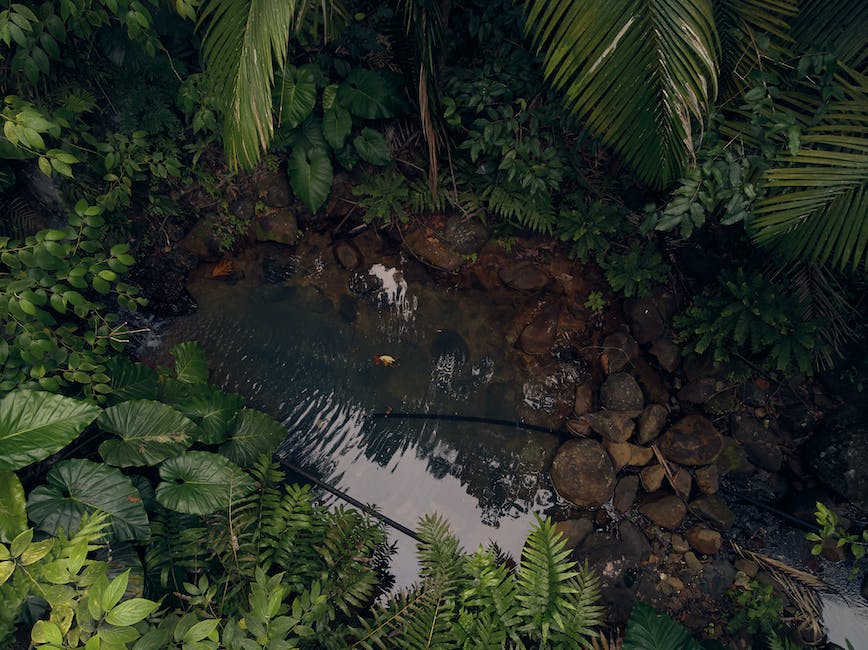Rocks can be a great addition to any landscape, but they should be used sparingly around palm trees. Rocks can retain heat and cause the roots of the palm tree to bake, which can damage the tree. Also, if the rocks are too close to the trunk of the tree, they can impede the tree’s ability to grow.
There is no definitive answer, as different people have different opinions on the matter. Some believe that rocks can help protect the roots of a palm tree from heat and sun damage, while others believe that rocks can trap moisture around the tree and lead to rot. Ultimately, it is up to the individual to decide whether or not they want to put rocks around their palm tree.
What is best to put around palm trees?
If you’re looking to add some additional plants to your palm tree landscaping, consider adding vines like jasmine. Not only are they fragrant and beautiful, but they can also provide some much-needed ground cover. Birds of paradise are another great option, as they offer pollination benefits and can help to fill in any bare spots. Finally, bougainvillea plants are a great way to add some color and vibrancy to your landscaping.
Mulch is an important tool for palm tree care. It helps to keep weeds and grasses from growing up close to the palm, which can sap nutrients and water from its root zone. Mulch also conserves moisture, making irrigation more efficient and increasing a palm’s drought tolerance during hot, dry weather.
Is it good to put rocks around trees
While rocks might make for a pretty decoration around your trees, they can actually do more harm than good. Not only can they damage your lawnmower if you’re not careful, but they also don’t add any nutrients to the soil like plant-based mulches do. So it’s best to avoid using rocks as mulch altogether.
There are many types of organic mulch that are good for gardens. However, palm mulch can be stringy and not as visually appealing as other types of mulch, such as pine straw, pine bark, or wood chips. I personally prefer mulch that is produced by tree service chippers, as it is often made from pine or broadleaf trees.
What can you not do with a palm tree?
1. Watering your palm tree too little – this will cause the leaves to turn yellow and eventually die.
2. damaging the roots of your palm tree – this will make the tree less stable and more likely to topple over.
3. fertilizing your palm tree too close to the trunk – this can damage the tree’s bark and make it more susceptible to disease.
4. not using fertilizer – without fertilizer, palm trees will not grow as large or as full.
5. not using good soil – poor quality soil will not provide the nutrients that palm trees need to thrive.
6. planting your palm tree in the wrong climate – if the climate is too cold, the tree will not be able to survive.
7. causing sunburn – if the tree gets too much sun, the leaves will start to turn brown and eventually die.
8. pruning your palm tree too much – this can weaken the tree and make it more susceptible to disease.
Epsom salt is a type of salt that is rich in magnesium. It is often used to increase the magnesium content in the soil for palm trees. Palm trees need higher amounts of magnesium for their growth.
Should I use rocks instead of mulch?
Mulch is a great option for those who are looking for low maintenance and it lasts a long time. Stone is a great option for those who live in dryer climates since it is not combustible and it keeps weeds away for a longer period of time.
Bright, indirect light is best for growing African violets. The plants prefer a loose soil mix with some fertilizer added during the growing season. Water carefully, keeping the soil moist but not soggy. Prune as needed to keep the plants tidy. Natural pesticides may be used if needed. A well-chosen container will help the plant thrive.
Why do people use mulch instead of rocks
Mulch vs Rock:
Mulch is a natural product that helps soil retain moisture and reduces evaporation on the surface. This means that you can water less often and the plants will still get the nutrients they need. Rock does not provide these benefits, so it is not as effective in supporting plant growth.
Landscaping with rock can significantly decrease the amount of water needed to support trees, shrubs, plants, and grass growth. Spreading small rocks around trees can serve as an inorganic mulch, preventing weed growth, regulating soil temperature, and retaining moisture.
Is it OK to put rocks around tree base?
It’s usually best to avoid placing rocks around trees, as this can damage the tree roots and ultimately the tree itself. However, if you must do so, make sure the rocks are small and placed carefully so as not to weigh down any surface tree roots heavily. There should also be 2-3 inches of uncovered soil around the tree trunk. Small rocks placed around the tree will help protect it as mulch, and bigger rocks placed as a border will reduce foot traffic.
If you have drainage issues on your property, rock is a great mulch choice. It allows water to drain quickly and doesn’t need any maintenance. Rocks are especially good for high-traffic areas, where pedestrians tend to take short cuts.
Should you peel bark off palm trees
When trimming palm bark, it is important to trim back to the living bark. This not only reveals the trunk of the tree, but eliminates the risk that it harbors pests. The shaggy fronds are favorite habitats of rats, snakes and scorpions. The dead material is also a fire hazard.
Coffee grounds, in addition to providing nutrients like nitrogen, phosphorus, potassium, calcium, magnesium, and copper to palm trees, are an excellent source of nutrition. Palm trees should be given coffee grounds in early spring and throughout their growing season. This will help the palm trees to grow healthy and strong.
Should you cover palm trees?
It’s a good idea to cover your palm tree on cold days. If your palm tree is small, you can cover it with a weighted down box or a blanket. On sunny days, partially open a box to avoid air heating up to damaging temperatures inside. This can happen even with the outside temperatures being below freezing.
Sand helps improve drainage by allowing excess water to quickly pass through the soil and away from plant roots. Too much water around plant roots can lead to problems such as root rot.
What does an unhealthy palm tree look like
There are a few things that could be causing your palm tree to become sick, but the most common sign is a browning or shriveling of the center stalk. Take a look at the top center portion of the tree and if you see this happening, then it’s time to take action. There are a number of possible causes of palm tree Sickness, but the most common one is a lack of water. Make sure to water your tree regularly and deeply, especially during hot summer months. If the problem persists, you may need to consult with a palm tree expert to get to the bottom of the issue.
If your palm tree’s leaves are turning yellow, it could be a sign that the tree is lacking essential nutrients. Make sure to check the tree’s soil for nutrients like nitrogen, manganese or magnesium and replenish as needed. Alternatively, a pest or fungus could be causing the leaves to yellow.
Conclusion
It is generally not a good idea to put rocks around palm trees. The roots of palm trees are relatively shallow and can be easily damaged by the weight of the rocks. Additionally, the rocks can hold moisture and encourage the growth of roots, which can then damage the tree.
There isn’t a definitive answer to this question since it depends on personal preferences. Some people might think that rocks around palm trees look aesthetically pleasing, while others might prefer a more natural look. Ultimately, it is up to the individual to decide what they think looks best.
Mark Hoffman is a dedicated arborist and tree care specialist with over a decade of experience. His love for trees began when he visited Yosemite National Park as a teenager and was awestruck by the giant sequoias. Mark pursued his passion by studying forestry at Michigan Technological University, where he earned a Bachelor of Science degree.
Since then, he has worked tirelessly in the field of arboriculture, helping to preserve and protect trees in his community. His expertise and dedication have made him a respected leader in the industry and a valuable resource for anyone seeking advice on tree care.
